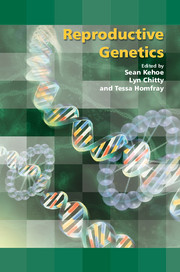Book contents
- Frontmatter
- Contents
- Participants
- Declarations of personal interest
- Preface
- 1 Genetic aetiology of infertility
- 2 Disorders of sex development
- 3 Preimplantation genetic diagnosis: current practice and future possibilities
- 4 Ethical aspects of saviour siblings: procreative reasons and the treatment of children
- 5 Epigenetics, assisted reproductive technologies and growth restriction
- 6 Fetal stem cell therapy
- 7 Prenatal gene therapy
- 8 Ethical aspects of stem cell therapy and gene therapy
- 9 Fetal dysmorphology: the role of the geneticist in the fetal medicine unit in targeting diagnostic tests
- 10 Fetal karyotyping: what should we be offering and how?
- 11 Non-invasive prenatal diagnosis: the future of prenatal genetic diagnosis?
- 12 Non-invasive prenatal diagnosis for fetal blood group status
- 13 Selective termination of pregnancy and preimplantation genetic diagnosis: some ethical issues in the interpretation of the legal criteria
- 14 Implementation and auditing of new genetics and tests: translating genetic tests into practice in the NHS
- 15 New advances in prenatal genetic testing: the parent perspective
- 16 Informed consent: what should we be doing?
- 17 Consensus views arising from the 57th Study Group: Reproductive Genetics
- Index
3 - Preimplantation genetic diagnosis: current practice and future possibilities
Published online by Cambridge University Press: 05 February 2014
- Frontmatter
- Contents
- Participants
- Declarations of personal interest
- Preface
- 1 Genetic aetiology of infertility
- 2 Disorders of sex development
- 3 Preimplantation genetic diagnosis: current practice and future possibilities
- 4 Ethical aspects of saviour siblings: procreative reasons and the treatment of children
- 5 Epigenetics, assisted reproductive technologies and growth restriction
- 6 Fetal stem cell therapy
- 7 Prenatal gene therapy
- 8 Ethical aspects of stem cell therapy and gene therapy
- 9 Fetal dysmorphology: the role of the geneticist in the fetal medicine unit in targeting diagnostic tests
- 10 Fetal karyotyping: what should we be offering and how?
- 11 Non-invasive prenatal diagnosis: the future of prenatal genetic diagnosis?
- 12 Non-invasive prenatal diagnosis for fetal blood group status
- 13 Selective termination of pregnancy and preimplantation genetic diagnosis: some ethical issues in the interpretation of the legal criteria
- 14 Implementation and auditing of new genetics and tests: translating genetic tests into practice in the NHS
- 15 New advances in prenatal genetic testing: the parent perspective
- 16 Informed consent: what should we be doing?
- 17 Consensus views arising from the 57th Study Group: Reproductive Genetics
- Index
Summary
History of preimplantation genetic diagnosis
Preimplantation genetic diagnosis (PGD) has developed dynamically over the past 19 years. It was first introduced for sexing embryos in the case of X-linked genetic disorders in 1990. In 1992, the first case of a live birth after successful PGD for the single-gene disorder cystic fibrosis was reported. PGD for single-gene disorders moved on a stage further in 1995 when a centre in Belgium reported the successful outcome of a pregnancy following PGD for Duchenne muscular dystrophy by detecting the dystrophin gene deletion. This resulted in a successful non-carrier female pregnancy. Since then, the worldwide development of PGD has expanded to offer testing for over 200 single-gene and chromosomal disorders. The technique has also diversified to include preimplantation genetic screening (PGS), which has been employed to improve in vitro fertilisation (IVF) outcome in subfertile couples and embryo testing for human leucocyte antigen (HLA) matching for sick siblings. Future developments will possibly include comparative genomic hybridisation (CGH) microarray technology that would enable testing for full chromosome aneuploidy and single-gene disorders from a single embryo biopsy. These new applications of the technology have been and remain controversial and will be discussed further below.
For the purposes of this chapter, it is important to first define the various forms of treatment available and the terminology used within the context of this chapter:
■ preimplantation genetic diagnosis is the testing of embryonic material (polar body, blastomere or blastocyst biopsy) for a single-gene or chromosomal abnormality that is recognised as a known risk for the couple
■ preimplantation genetic screening involves testing embryonic material for the presence of aneuploidy where there is no underlying risk of an inherited abnormality.
Keywords
- Type
- Chapter
- Information
- Reproductive Genetics , pp. 35 - 58Publisher: Cambridge University PressPrint publication year: 2009

